EXTRACTS full text here
INTRODUCTION TO THE PRISONER
Arrival is, at least for the first two of its three sections, an astonishing piece of visual art. Such is its visual power that its distinctive imagery alone tells all the essentials of the story. The locations – consisting of familiarly iconic parts of London and the eccentrically cosmopolitan setting of the Portmeirion Hotel in North Wales – are especially distinctive, and work in sharp contrast against each other, taking us from an extremely familiar setting into one which is mysterious and strange. The studio sets, in particular The Prisoner’s house, Number 2’s residence inside The Green Dome and the Village’s main surveillance centre are meticulously designed modernist interiors which reflect the rulers of The Village’s use of the most up to date technology. These provide another contrast with the old-world architecture of Portmeirion, indicating that beneath the facades The Village represents a technologically controlled and totalitarian future. Every aspect of the episode’s mise-en-scene has been utilised to reinforce this contrast.

THE PRISONER ARRIVAL
The (superficially) comforting environment of The Prisoner’s house features muted, soft greens and yellows while inside The Green Dome everything is dark blue, purple and metallic grey. The black blazers, casual slacks and colourful striped tee shirts worn by the inhabitants of The Village suggest a kind of ‘holiday camp’ atmosphere but the clothes themselves are all so perfectly and immaculately clean, and the actions of the Villagers – as they take part in contrived ‘fun’ – are awkward, nervous and completely desexualised. There is plenty of contrasting colour here, the visuals tell us, but precious little passion. The styles of the Portmeirion buildings, which are drawn from many different parts of the world and which seem to be arranged in an almost random way, add to the sense of dislocation which both The Prisoner and the viewer increasingly come to feel.

Central to the design strategy of the series, as revealed in Arrival, is the imaginative positioning of rounded shapes, which appear in sharp contrast to the rectangular frame of the TV screen. Number 2’s ‘office’ is circular, with built in monitor screens all around. Number 2 himself rises up from below, with measured amusement, in a strange chair shaped like half an egg. In the middle of the room is a large round control console. In the surveillance room the operatives swing round on a kind of wheel with their heads bent down over their equipment. And most memorably of all there is what later becomes known as ‘Rover’, the mysterious and terrifying white balloon which appears to be both Village guard and instrument of punishment. Even the ubiquitous typescript which all Village signs and notices are written in is heavily rounded.
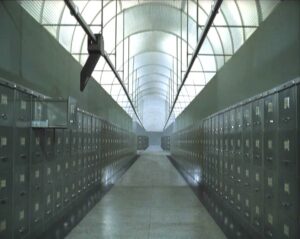
THE PRISONER OPENING SEQUENCE
The opening sequence, which appears here in fully extended form, tells the story of The Prisoner’s incarceration in a completely visual way. The sequence is poetically cinematic, beginning with the cracking of thunder and long a shot of an anonymous deserted airfield. It is as if he comes out of some elemental place. We then see our hero’s stylish Lotus 7 crashing towards us. The dynamic music is, here as elsewhere, crucial to the effect, rising to a series of climaxes as we see him driving through London, entering a secret underground location, smashing his fist down on hiss boss’s desk and then storming back down the corridor. The music is slightly orchestrated, but a driving rock beat features throughout, like a racing heartbeat, slowing down to a slower rhythm as he returns to his London home, rising in tempo as he struggles with the effect of the knockout drug that his been posted through his letterbox by a tall, spindly man dressed as an undertaker, then petering out he collapses, the buildings racing around in front of his eyes. When he wakes the music is calm but slightly eerie as he opens up the blinds to reveal his entrance to his ‘new world’. His apartment in The Village has been set up as a replica of his London flat, as if to further disorient him and to display the apparently effortless omnipotence of his captors.
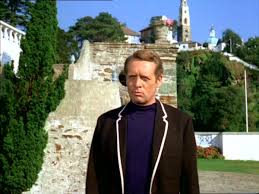
The appearance of the mute, midget butler, who we see for the first time here, is another unsettlingly strange visual component which will be a constant factor throughout the series. The butler greets The Prisoner and escorts him to the entrance to Number 2’s ‘office’. Here the music changes abruptly into an eerie, ‘futuristic’ theme appropriate to the remarkably distinctive design of the large circular room, with its surrounding hi-tech screens which initially are filled with the floating blob-like shapes which are a distinctive feature of the series. We also get our first glimpse of the penny farthing bicycle, a symbol of redundant and outmoded technology which is in distinct contrast to its highly technological surroundings. As The Prisoner makes his first key statement of resistance: …I will not be pushed, filed, indexed, stamped, briefed , debriefed or numbered… my life is my own… we see his face in stark close-up, the weird floating shapes circling behind him. This is perhaps the most iconic image in the whole series, with McGoohan’s face set in firm, angry defiance. Our hero’s direct language contrasts with the exaggerated all-knowing politeness of his host. Later The Prisoner is asked to answer a ‘questionnaire’ at the Village ‘Labour Exchange’, another circular-shaped ‘futuristic’ interior, conducted by a mild mannered bureaucrat spinning a wheel on an oddly constructed wooden child’s toy which our hero smashes in frustration before exiting. The iconography of the Village is dominated by circles and wheels. And as with the Penny Farthing bicycle, there are Big Wheels and Little Wheels….
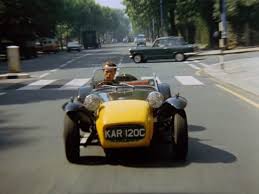
Most of the rest of the episode becomes more melodramatic, divided between the Village’s attempts to get information out of The Prisoner and his efforts to escape. A pretty girl, assigned to him as his maid, breaks down in front of him and begs him to give her some information to stop her being punished. He can clearly see he is being manipulated and refuses to fall for it, giving her short shrift. After his futile attempt to escape via the beach are defeated by the arrival of Rover, a whole mini-drama unfolds when Cobb, a former secret service colleague appears in the Village hospital and appears to sympathise with him. The authorities then fake Cobb’s suicide in order to manipulate The Prisoner into a plot by which he has to gain the sympathy of a young woman who had apparently been in love with Cobb in order to gain access to the Village helicopter. However, both the woman and Cobb are actually working for the Village and The Prisoner’s escape attempt in the helicopter is cynically curtailed by the replacement Number 2.
The point of the exercise seems to have been merely to show The Prisoner just how futile any effort to escape would be. Here, as in several places in the episode, the ‘spy plot’ of the episode is emphasised. It appears that The Village is some kind of international prison where ex-spies will be taken to have any valuable information extracted from them. The viewers may even assume that McGoohan’s character is actually John Drake from Danger Man, especially as in many ways McGoohan appears to be still acting the part of this character. At this point the influence of script editor George Markstein, who envisaged the series as basically a sophisticated version of a spy drama, was still strong. In some ways the more surreal aspects of the episode, which are largely executive producer McGoohan’s own creation, sit uneasily with this.
The ‘spy plot’ is in fact utterly bereft of defining detail. We do not learn why The Prisoner has resigned, which organisation he has really resigned from or what his motives were. These elements become the enigmas that keep us watching through the succeeding episodes. But as the series progresses, the quest for this apparently basic information becomes not only that of the viewer but that of his captors. Gradually the ‘spy’ elements recede, Markstein himself resigns and McGoohan’s vision comes to dominate the series.

THE PRISONER AND THE SPY GENRE
Such was the originality of The Prisoner that it soon built up impressive viewing figures as spectators were drawn in more and more by desire to know the answers to the series’ unanswered questions. As the series developed, the nature of these questions began to subtly shift. This use of continually evolving enigmas is an especially distinctive trait of long running television series, which must continually provide reasons for their audience to keep watching. The elements of the secret agent genre which dominate the last third of the episode were comfortably familiar ground for an audience attuned to both the fantasy of James Bond, and the relative realism of Harry Palmer from The Ipcress File or the John Le Carre novels.
The apparently seamless transition of McGoohan’s character from his Danger Man persona only adds to this effect. As Cobb leaves Number 2 says to him …Give my regards to the old country… Already the viewer suspects that The Village is the creation of some kind of secret multinational organization, perhaps like Spectre in the Bond films. Or maybe it is run by the Commies, or quite possibly, by Our Lot. Arrival sets up all these generic expectations in the audience. Yet in its setting, and the strange dream-like logic with which events occur, it already hints at the ‘mind trips’ it will soon be taking its audience on.
British TV audiences were already accustomed this kind of ‘proto-psychedelia’ in more ‘lightweight’ ‘spy spoof’ shows like The Avengers. But in Arrival there are already hints that we are in far darker territory. In the Village ‘hospital’ waiting room, signs written in the heavy, childlike ‘Village script’ declaim slogans such as … a still tongue makes a happy life… The ‘patients’ engaged in what Number 2 blithely calls ‘therapy’ appear to be the subjects of Nazi-like experimentation.

Arrival is a tour de force in televisual terms, an utterly compelling, beguiling and outlandish episode which crams an amazing amount of information into its fifty minutes. It clearly establishes the highly distinctive visual world of The Prisoner and begins to outline its philosophical position. At the same time it retains many of the conventions of action-adventure TV, such as highly choreographed chase scenes and fight scenes. But even these are conveyed with a kind of visual inventiveness in terms of both set design (mise en scene), editing and camera work that had rarely, up that point, been seen in any form of television show. The episode sets out the dramatic and visual boundaries of the series, creating stunningly original and literally unforgettable visual and verbal juxtapositions with the use of costume, scenery and highly distinctive props such as ‘Rover’ and the Penny Farthing bicycle. Its visual qualities show its creators’ delight in what was for TV the new medium of colour, while its script creates delicious layers of enigma, in which we as viewers are already relishing the process of immersing ourselves.
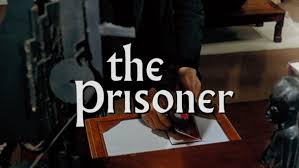


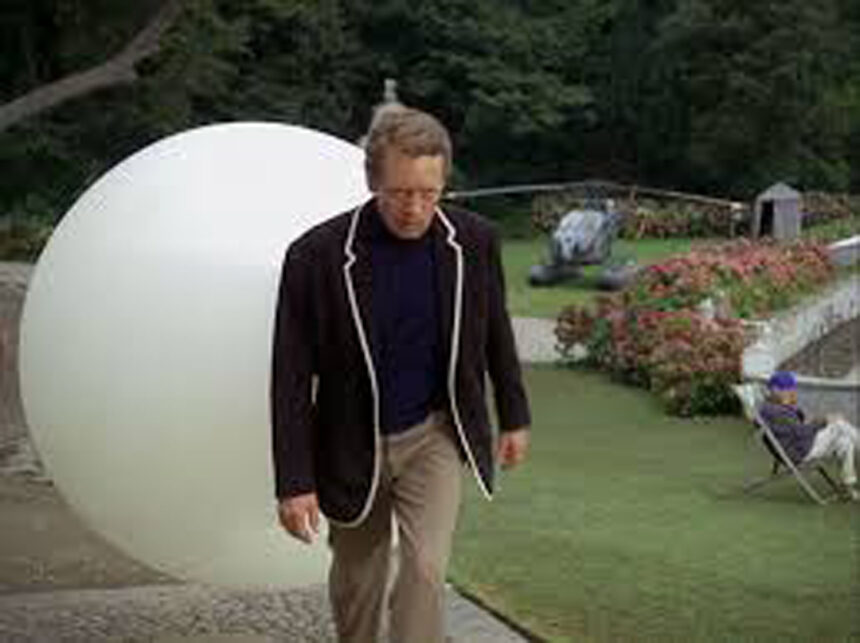
Leave a Reply